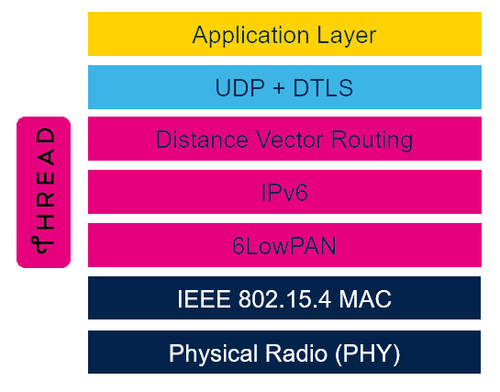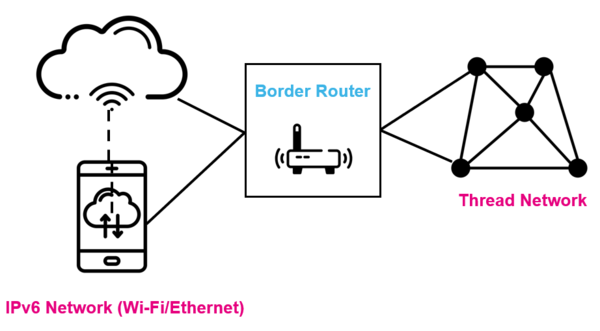1. Introduction
Thread is an IPv6-based, low power, reliable, and secure mesh networking protocol for the IoT that are developed and supported by Thread Group
[1]. It is designed specifically for Home Automation applications.
The Thread standard is based on IEEE 802.15.4 MAC and physical layer operating at 250 kbps in 2.4 GHz band.
OpenThread is an open-source implementation of Thread released by Google [2].
OpenThread running on the STM32WB [3] is a Thread certified component.
The STM32WB is a certified component for whatever Full Thread Device or Minimal Thread Device type of role is intended.
2. Thread specification
Thread is a networking layer based on IPv6. The Thread specification is based on seven layers as shown in the figure below. It uses the IEEE 802.15.4 PHY and MAC layers for link layer communication. MAC layer supports a maximum packet size of 127 bytes. IPv6 requires a minimum of 1280 bytes of MTU. For that, 6LoWPAN performs IP packet fragmentation and header compression to fit in 127 bytes.
3. Node roles
Nodes in Thread network can be either full thread device (FTD) or minimal thread device (MTD).
A FTD node always has its radio On. An MTD node could be a sleepy end device (SED) which is normally Off, and wakes on occasion to get messages from its parent.
In a Thread network, a device can take one of the following four roles.
Note that all devices start as ED and are ...
3.1. Thread router
A router is responsible to transmit, receive, and forward messages over the network.
3.2. Thread leader
A leader is a router that has been elected to be responsible of managing assigned routers in a Thread network partition.
3.3. Thread end device
An end device (ED) is a node that communicates with a single router. If it loses the connection to its parent, it seeks to find a new one.
3.4. Thread border router
A Thread border router (TBR) is a specific router that connects a Thread network to other IPv6-based networks like Wi-Fi or Ethernet.
A Thread network can contain one or more TBRs.
4. Thread no single point of failure
Thread system is designed to be reliable with no single point of failure. It means that in Thread network none of its devices represent a single point of failure.
Thread network operates in a manner that any device can be replaced automatically and without impacting the communication if there is a problem. For example, if a SED loses its parent, which represents a single point of failure, it can select another parent in an imperceptible way. The most common example of this feature is that if the leader is lost, the router can become the new leader, and the Thread network is recovered.
5. Acronyms and definitions
| Term | Definition |
|---|---|
| DTLS | Datagram transport layer security |
| FTD | Full thread device |
| IPv6 | Internet protocol version 6 |
| MAC | Media access control |
| MTD | Minimal thread device |
| PHY | Physical |
| SED | Sleepy end device |
| UDP | User datagram protocol |
6. References

